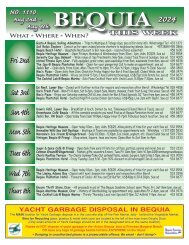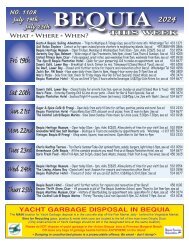Caribbean Compass Yachting Magazine - November 2020
Welcome to Caribbean Compass, the most widely-read boating publication in the Caribbean! THE MOST NEWS YOU CAN USE - feature articles on cruising destinations, regattas, environment, events...
Welcome to Caribbean Compass, the most widely-read boating publication in the Caribbean! THE MOST NEWS YOU CAN USE - feature articles on cruising destinations, regattas, environment, events...
You also want an ePaper? Increase the reach of your titles
YUMPU automatically turns print PDFs into web optimized ePapers that Google loves.
LOOK OUT FOR…<br />
Life is Just a Bowl<br />
of Barbados Cherries<br />
by Lynn Kaak<br />
As you travel through the <strong>Caribbean</strong>, every month there’s something special to look<br />
out for.<br />
West Indian cherry, Acerola, Barbados cherry, or whatever you may end up calling<br />
it, Malphigia emarginata is one to remember. Frequently made into juice, it also is an<br />
integral ingredient in local cherry cakes and jams, as well as other delectable delights.<br />
While usually more tart and acidic than its more temperate counterparts, the fruit<br />
from this tree is a nutritional power plant. It is extremely rich in vitamin C (one<br />
cherry has your daily requirement!), as well as vitamin A, and the B vitamins 1, 2,<br />
and 3. Antioxidants abound, and it is also a notable source of manganese. A glass<br />
of this juice will do a body good. It also mixes very pleasantly in a fruit punch. The<br />
fruit is used commercially for vitamin tablets; however, getting it straight from the<br />
source seems so much better!<br />
This tropical evergreen grows as a shrub or a short tree. It doesn’t tend to get above<br />
heights of about six metres (20 feet), and tends to be closer to about three metres<br />
(ten feet) tall. Its dense foliage and crown make for a decent privacy hedge, and the<br />
tree can even be sculpted somewhat in the manner of bonsai. This sun-loving tree<br />
loves to sink its roots into soil on the sandy side, but since those roots don’t go deep,<br />
the tree is susceptible to windstorms and is better off in a protected area.<br />
The leaves are somewhat oval and come to a point. They may appear to be a little<br />
crinkled, with a look that lends another name: Wild Crepe Myrtle. The leaves have small<br />
stems, and tend to grow opposite to one another. They have tiny hairs that might irritate<br />
the skin if they are handled too much. They are found on the tree all year around.<br />
The flowers are one to two centimetres in diameter with five fringed petals. They can<br />
be a pale pink to a fairly deep red, and grow in clusters of three to five flowers. With<br />
the flowers being bisexual, pollination is not difficult for the tree. With the size of the<br />
flowers being relatively small, insects and the wind tend to be the main pollinators.<br />
The fruit are small and red, looking very… well, cherry-like, growing in small<br />
clumps. The small bright red orbs have three small seeds inside. Trees can bear fruit<br />
three times per year, so you don’t have to wait too long for the next batch to appear.<br />
They can be eaten raw and are pleasant tasting, and the right conditions can make<br />
them sweeter. While they don’t last long after ripening, they can be kept a little<br />
longer with refrigeration or freezing.<br />
These cherries are indigenous to the area from southern Mexico to the northern<br />
parts of South America, as well as the <strong>Caribbean</strong> Basin. The trees can now be found<br />
throughout the tropics, and even reach into the subtropics. The trees don’t do well<br />
if the temperature hits around the freezing point, so care is required in areas like<br />
Florida if the temperature drops.<br />
These trees can be seen almost everywhere around the <strong>Caribbean</strong> where the soil is<br />
a little sandier and the elevation isn’t too high. While popular for landscaping, they<br />
can also be found in areas with no close habitation.<br />
NOVEMBER <strong>2020</strong> CARIBBEAN COMPASS PAGE 23<br />
Martinique Offi ce<br />
Douglas Yacht Services<br />
Marie-Eugénie Kieffer<br />
M +596 696 25 08 56<br />
E marie-eugenie@douglasyachtservices.fr<br />
sevenstar-yacht-transport.com

















